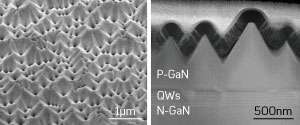Textured LED gives green light to Li-Fi

Standard light-emitting diodes (LEDs) used for home lighting can now transmit data more rapidly between electronic devices, thanks to new research from A*STAR.
Wireless visible light communication—also known as Li-Fi—relies on data signals encoded in incredibly brief pulses of light, far too quick for the eye to see. By supplementing congested Wi-Fi networks, Li-Fi could increase the capacity and speed of data transmission in offices, homes and public spaces. However, white LEDs typically use a phosphor coating to create a natural-looking white light, and the time it takes for the phosphor's glow to fade away limits how quickly the LED can transmit data.
Previous solutions typically required installing new types of white LEDs. Instead, Ee Jin Teo of the A*STAR Institute of Materials Research and Engineering, and colleagues, have developed a Li-Fi receiver that overcomes these problems. Rather than using a conventional silicon photodiode to detect transmissions, they found that an indium gallium nitride (InGaN) LED is an effective data receiver.
Crucially, the team's InGaN LEDs can detect only the 'fast' blue component of the phosphor's white light, which fades in only one nanosecond, and not the 'slow' yellow component which takes more than 50 nanoseconds to fade away.
The researchers also gave their InGaN LED a textured surface, so that every square centimeter was covered with one billion V-shaped pits (see image), roughly 150 nanometers deep. These V-pits scatter incoming light, allowing the LED's active layers to absorb more than twice as much blue light as an LED with a smooth surface.
Tests with a white LED showed that the InGaN LED with V-pits was a much better receiver than a standard silicon photodetector. "Using a silicon photodetector, the white LED can reach a switching speed of five megahertz—this typically means a data transmission rate of up to 100 megabits per second," says Teo. "With our InGaN LED as a detector, this switching speed can be increased by four times, enabling faster data transmission rates from white LEDs."
She notes, however, that since the receiver is only picking up part of the white LED's light, it may reduce the range over which data can be transmitted.
"The next stage of our research," she adds, "is to implement this concept into a dongle where the same LED can be used for transmission as well as detection of data."
More information: Chengyuan Yang et al. Textured V-Pit Green Light Emitting Diode as a Wavelength-Selective Photodetector for Fast Phosphor-Based White Light Modulation, ACS Photonics (2017). DOI: 10.1021/acsphotonics.6b00867
Journal information: ACS Photonics



















